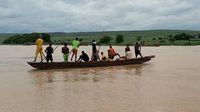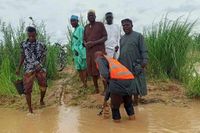On Sunday, August 17, 2025, a tragic boat accident unfolded on the River Goronyo in Sokoto State, northwestern Nigeria, leaving more than 40 people missing and sparking a massive search and rescue operation. The vessel, reportedly overloaded with over 50 passengers, was en route to the bustling Goronyo Market—a vital hub for local food trade—when it capsized mid-journey, according to statements from Nigeria’s National Emergency Management Agency (NEMA) and corroborated by multiple local and international news outlets, including Reuters, BBC, and The Punch.
The immediate aftermath was chaotic and heart-wrenching. As of Monday, August 18, rescue workers had managed to pull only 10 survivors from the river, with at least 10 confirmed dead, and more than 40 individuals still unaccounted for. The precise number of victims remains uncertain, as the passenger manifest was not strictly enforced—a recurring issue in such incidents. Local authorities, including the Sokoto State Emergency Management Agency (SEMA), have been working alongside NEMA, deploying teams of divers and volunteers to scour the riverbanks and waters in hopes of finding more survivors. "Search and rescue operations are ongoing to locate the remaining passengers," SEMA said in a statement shared with The Punch.
The accident has cast a pall of grief over the communities along the river. "This is indeed a great tragedy for our community," a local resident told The Sun, describing an atmosphere of tension and sorrow in the nearby town of Kojiyo. The sense of loss is palpable, with families anxiously awaiting news of their loved ones as rescue efforts stretch into their second day. Hon. Aminu Liman Boding, Special Adviser of SEMA, expressed condolences to the bereaved families and urged, "We urge community members to adhere strictly to safety regulations and avoid overloading boats."
Boat accidents of this scale, unfortunately, are far from rare in Nigeria, especially during the rainy season from March to October. Swollen rivers and unpredictable currents increase the danger, but the underlying issues run deeper. Overcrowding, poorly maintained vessels, and a widespread failure to enforce safety regulations have made such tragedies a grimly regular occurrence. According to TheCable, at least 326 people died in boat accidents across Nigeria in 2024 alone—a staggering figure that underscores the persistent risks facing riverine communities.
Last month, a similar disaster struck in Niger State, north-central Nigeria, when a boat carrying around 100 passengers capsized, resulting in at least 13 deaths and dozens more missing, as reported by Reuters. Just two days after that, six girls drowned in Jigawa State when their boat sank while returning from farm work. These incidents are part of a distressing pattern: in December 2024, 54 bodies were recovered from the River Niger after a boat overloaded with more than 200 passengers capsized, and a month earlier, nearly 200 perished when a wooden canoe packed with almost 300 people overturned in the same river, according to BBC. Two years ago, more than 100 people drowned in southwestern Nigeria when a vessel carrying wedding guests from Kwara State to Niger State sank.
Why do these tragedies keep happening? Analysts and local officials point to a combination of factors. Many boats operate without the most basic safety equipment—life jackets are supposed to be mandatory under Nigerian regulations, but are often unavailable or simply not enforced, especially in rural areas. Weak oversight from regulatory authorities allows operators to ignore passenger limits and maintenance standards. "Many boats operate without life jackets, blaming weak enforcement by regulatory authorities," TheCable reported, echoing concerns raised by community members and safety advocates.
The Goronyo accident appears to fit this pattern. Early reports suggest that overloading was a likely cause, a recurring issue in the region’s riverine transport. Wooden canoes and other makeshift vessels are frequently pressed into service to meet the high demand for market access, particularly during the harvest season. With few alternatives and little government investment in safer transport infrastructure, residents often have no choice but to risk their lives on the water.
In response to Sunday’s disaster, NEMA Director General Zubaida Umar and the Sokoto Operations Office launched a coordinated rescue mission, pledging to "save lives, provide timely updates, and coordinate all necessary support for the affected families." The agency has intensified its efforts, collaborating with local authorities and emergency responders to comb the river and its banks. "The Agency reassures the public of its commitment to saving lives, providing timely updates, and coordinating all necessary support for the affected families," NEMA said in a public statement.
The Sokoto State government, for its part, has deployed additional response teams and called for stricter adherence to safety protocols. Special Adviser Boding emphasized the need for community vigilance: "We urge community members to adhere strictly to safety regulations and avoid overloading boats." Yet, as many in the region know all too well, such appeals often go unheeded in the absence of effective enforcement and viable alternatives.
The human toll of these accidents is not limited to the immediate loss of life. Survivors and families of the missing face long-term psychological trauma, economic hardship, and a pervasive sense of insecurity. Markets like Goronyo are lifelines for rural economies, and disruptions caused by such tragedies ripple through entire communities. Local leaders have called for greater government investment in safe, reliable transportation and a renewed commitment to enforcing existing safety regulations.
As rescue operations continue, the mood in Sokoto State remains somber but resolute. Volunteers, local divers, and emergency personnel are working against the clock, knowing that the chances of finding additional survivors diminish with each passing hour. The story is a stark reminder of the dangers faced daily by millions in Nigeria’s riverine regions—and of the urgent need for systemic reforms to prevent future catastrophes.
With the rainy season still in full swing and river travel a necessity for many, the tragedy on the River Goronyo is unlikely to be the last. But for the families waiting on the riverbanks, hope endures that their loved ones might yet be found, and that real change could finally be on the horizon.


